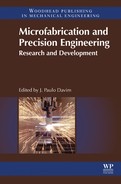Table of Contents
1. Modeling of micro- and nano-scale cutting
1.2 Modeling of microscale cutting
1.3 Modeling of nanoscale cutting
2. Machining scale: Workpiece grain size and surface integrity in micro end milling
2.4 Workpiece microstructure scale
3. Micromachining technique based on the orbital motion of the diamond tip
3.2 Principle of micromachining using the orbital motion of the diamond tip
3.3 Micromachining setup and test of the stage’s trajectory
3.4 Micromachining mechanism using the orbital motion of the tip
3.5 Formation mechanism and control methods of burrs
3.6 Effects of the processing parameters and fabrication of microstructures
4.2 Principle of electrical discharge machining
4.4 Differences between EDM and micro-EDM
4.5 System components of micro-EDM
4.6 Micro-EDM process parameters
4.7 Performance criteria in micro-EDM
4.8 Titanium alloys as advanced engineering materials
4.9 Literature review of micro-EDM of Ti-6Al-4V
4.10 Investigation of micro-EDM process employing innovative machining strategies
5. Microelectrochemical machining: Principle and capabilities
5.1 Fundamentals of microelectrochemical machining
5.2 Variety of micro-ECM processes
5.3 Hybrid processes associated with microelectrochemical machining
6. Microchannel fabrication via direct laser writing
6.2 Important materials for MEMS and microfluidic devices
6.3 Lasers for microfabrication
6.4 Material removal mechanisms
6.5 Laser microprocessing of materials
6.6 Challenges and future of laser processing
7. Underwater pulsed laser beam cutting with a case study
7.3 Laser material interaction
7.5 Underwater laser beam machining
7.6 Pulsed IR laser ablation of Inconel 625 superalloy at submerged condition: A case study
8. Glass molding process for microstructures
8.1 Application of microstructures
8.2 Fundamental of glass molding technique
8.3 Modeling and simulation of microstructure molding
